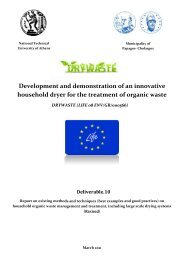MOROCOMP (LIFE TCY05/MA000141) - Unit of Environmental ...
MOROCOMP (LIFE TCY05/MA000141) - Unit of Environmental ...
MOROCOMP (LIFE TCY05/MA000141) - Unit of Environmental ...
You also want an ePaper? Increase the reach of your titles
YUMPU automatically turns print PDFs into web optimized ePapers that Google loves.
Biochemical Oxygen Demand (BOD 5 ) is a measure <strong>of</strong> the amount <strong>of</strong> oxygen that<br />
bacteria will consume while decomposing organic matter under aerobic conditions.<br />
Biochemical oxygen demand is determined by incubating a sealed sample <strong>of</strong> water for<br />
five days and measuring the loss <strong>of</strong> oxygen from the beginning to the end <strong>of</strong> the test<br />
[39]. According to Trujillo et al. leachates originating from wastewater sludge<br />
composting processes are characterized by increased BOD 5 values reaching up to 70<br />
g/L [40]. The initial sample <strong>of</strong> leachates derived from the 1 st composting trial acquired<br />
an increased initial BOD 5 value <strong>of</strong> 50.9g/L on the 3 rd day. As the process develops the<br />
organic intermediate products undergo complete bioxidation to CO 2 while the non<br />
biodegradable or less susceptible to degradation compounds accumulate. Therefore<br />
the microbial activity gradually decreases and the used oxygen by the biological<br />
organisms in leachates is reduced as the process continuous. For this reason the BOD 5<br />
evolution during composting presented a downwards inclination and at the end <strong>of</strong> the<br />
process leachates had been reduced approximately 1/6 <strong>of</strong> the initial BOD 5 value.<br />
Leachates acquired at the initial stage <strong>of</strong> composting a light dark colour which was<br />
gradually becoming darker as composting was developing. This is indicative <strong>of</strong> the<br />
presents <strong>of</strong> humic/fulvic and other complex compounds which are dark coloured,<br />
hydrophilic organic compounds whose molecular weight varies from few hundreds to<br />
few thousands. Ammonium and nitrates in leachates followed the same pattern as the<br />
ammonium and nitrates <strong>of</strong> the substrate indicating that the composting process was<br />
well monitored since the conditions were in favor <strong>of</strong> nitrification. Ammonium ions<br />
concentration presented a steep increase during the first days <strong>of</strong> composting reaching<br />
to a maximum <strong>of</strong> 1985.06mg/L on the 7 th day. From that day onwards ammonium<br />
concentration kept reduced and on 23 rd day their concentration in leachates was<br />
450.84mg/L. Nitrates in leachates presented a significant increase throughout the<br />
duration <strong>of</strong> the 1 st trial. On the 3 rd day their concentration was limited at 34.05mg/L<br />
while on the 23 rd day it had been increased approximately 12 times reaching at<br />
687.51mg/L. Table 6 shows also that heavy metals such as Cd, Cr, Cu, Ni, Pb and Zn<br />
were present in leachates throughout the process. The metal concentrations were<br />
much below the indicative values for wastewater disposal as shown in Table 7.<br />
48










